
Rockhounding Idaho
Idaho is an extraordinary state for rockhounding. Idaho's nickname is 'The Gem State.' Originally suggested as the name for the land that became the State of Colorado, the name "Idaho" was used for a steamship that traveled the Columbia River. With the discovery of gold on the Clearwater River in 1860, the diggings began to be called the Idaho mines. "Idaho" is a coined or invented word, and is not a derivation of an Indian phrase "E Dah Hoe (How)" supposedly meaning "gem of the mountains." Idaho’s mountains have rich veins of silver (and other metals such as gold, lead, and zinc). In addition to the state’s rich mineral ore legacy, Idaho also has garnets, opal, agates, jasper, quartz, petrified wood, and a wide variety of fossils. The state also is home to an incredible variety of geological formations including immense lava flows and Hell’s Canyon, the deepest canyon in the U.S. In addition, five meteorites are known to have been found in Idaho.
State Rocks, Gemstones, Minerals, Fossils, & Dinosaurs
Rockhounding Tip: Knowing state rocks, gemstones, minerals, fossils, and dinosaurs often can be very useful information for rockhounders. Ordinarily, states with significant mineral deposits, valuable gemstones, fossils, or unusual or significant rock occurrences will designate an official state mineral, rock/stone, gemstone, fossil, or dinosaur to promote interest in the state’s natural resources, history, tourism, etc. Accordingly, such state symbols often are a valuable clue as to potential worthwhile rockhounding opportunities.
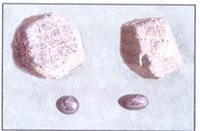
Star Garnet
State Gemstone:
Star Garnet (1967)
Idaho designated the star garnet as its
official state gemstone in 1967. Star garnet is an unusual form of
garnet. Asterism, or
the star effect, is associated mostly with sapphire and star ruby. But, fact a small of group of other gemstones
also can exhibit this effect though specimens are fairly rare. The other star gems include: chrysoberyl, citrine, diopside, emerald,
moonstone, quartz, & spinel. Star
garnets are so rare that thus far they have only been found in two places in
the world: in the state of Idaho and in India.
The 12-sided (dodecahedron) crystals found in Idaho range in size from
sand particles to golf-ball or larger size.
The garnet varieties that occasionally exhibit asterism are almandine
and a mixture of almandine and pyrope garnet.
Star garnets usually are opaque and colored a deep brownish red or a
reddish black. Like all star gems, the
star effect is caused by inclusions of rutile.
But in order to display the star effect the rutile needles must have the
right alignment to reflect light in a pattern forming a multi-ray star. Most Idaho star garnets display a 4-ray star,
but 6-ray stars are sometimes seen.
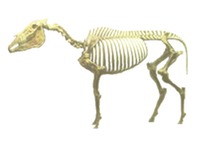
Harerman Horse
State
Fossil: Hagerman Horse Fossil (1988)
Idaho designated the Hagerman Horse
Fossil as its official state fossil in 1988.
Discovered in 1928, the Hagerman Horse
originally was described as Plesippus shoshonensis. Subsequent research found the Hagerman horse
to be the same as a previously described species discovered in Texas and named
by paleontologist Edward Drinker Cope as Equus simplicidens. The Hagerman horse is the oldest known
representative of the modern horse genus Equus (includes horses, donkeys, and
zebras) and is believed to be more closely related to the living Grevy's zebra
in Africa. The 3.5 million year old
sediments at the Hagerman Fossil Beds National Monument contain the world's
richest known fossil deposits from the late Pliocene epoch. They have yielded about two hundred horse
skeletons, twenty of which are complete. The more than 200 vertebrate, invertebrate,
and plant species preserved there represent the last vestiges of animals that
existed prior to the Ice Age and the earliest appearances of modern flora and
fauna.
Rockhounding Resources

State-specific rockhounding books (including the books listed here as well as other books), regional rockhounding site guides, and other helpful rockhounding resources are identified - by category - in the Books & Gear section of Gator Girl Rocks with a link to the Gator Girl Rocks Amazon Store where you may easily browse selected resources and securely place an order. Your order will benefit Charity Rocks!

- Lanny R. Ream, Idaho Minerals: The Complete Reference and Guide to The Minerals of Idaho (2d ed. 2004).
- Lanny R. Ream, The Gem & Mineral Collector's Guide to Idaho (Rev. ed. 2000).
- John A. Beckwith, Gem Minerals of Idaho (Rev. ed. 1972)
- David D. Alt & Donald W. Hyndman, Roadside Geology of Idaho (1993).
- H.C. Dake, Northwest Gem Trails (3d ed. 1962 - originally published in 1950).
- Garret Romaine, Rockhounding Idaho (2010).
- Allan W. Eckert, Earth Treasures Vol. 3 - Northwestern Quadrant (1986; reprint in 2000).
- James Martin Monaco & Jeannette Hathway Monaco, Fee Mining & Rockhounding Adventures in the West (2d ed. 2007).
- Kathy J. Rygle & Stephen F. Pedersen, Northwest Treasure Hunter's Gem & Mineral Guide (4th ed. 2008).
Museums of Interest to Rockhounders
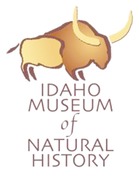
Idaho Museum of Natural History
Idaho State University – Pocatello, Idaho
The museum exhibits Idaho rocks, minerals,
gemstones, and fossils. In addition, the
museum’s ‘Trackways of Idaho’ exhibits 200 million year old tracks from
spiders, dinosaurs, and early mammals preserved in southern Idaho
sandstone. The museum’s exhibits also
include ice-age megafauna fossils. The
Pleistocene fossils include saber-tooth cats, giant bison, and the Hagerman
horse.

Idaho Museum of Mining & Geology
Boise, Idaho
The museum exhibits rocks, minerals, gemstones,
fossils, and artifacts.
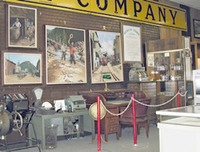
Wallace District Mining Museum
Wallace, Idaho
Wallace, Idaho is famous as the Silver Capital
of the World. Over a billion ounces of
silver has been extracted from the rich mines in this mineral rich area (the
mines also produce gold, lead, and zinc).
My great grandmother was married in Wallace, Idaho … so, you know I had
to stop and see the town, the mining museum … and eat an ice cream cone with
dad.
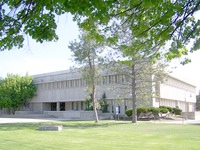
Orma J. Smith Museum of Natural History
The College of Idaho – Caldwell, Idaho
The museum, located in Boone Hall, exhibits
rocks, minerals, and fossils. The
college also exhibits the Glen L. and Ruth M. Evans Gem and Mineral Collection that
includes approximately 2,000 cabochons.

Shoshone County Mining & Smelting Museum
Kellogg, Idaho
In addition to extensive displays regarding the
Bunker Hill Mining District, the museum exhibits local minerals as well as
minerals from around the world.
Places to Visit - Interesting Sites To See

Hagerman Fossil Beds National Monument
Hagerman, Idaho
The Hagerman Fossil Beds National Monument is
home to the largest concentration of Hagerman Horse (Equus simplicidens)
fossils in North America, including thirty complete horse fossils and portions
of two hundred individual horses.
This
internationally significant Monument protects the world's richest late Pliocene
epoch (4 - 3 million years ago) fossil deposits: over 220 species of plants and animals!
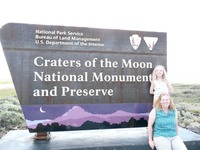
Mom and me on a hot summer day in 2009.
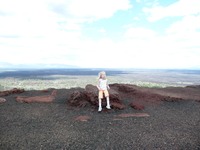
Lava everywhere at Craters of the Moon.
Craters of the Moon National Monument & Preserve
South Central Idaho near Arco, Idaho
The Craters of the Moon National Monument &
Preserve is a vast ocean of lava flows with
scattered islands of cinder cones and sagebrush. Over the past 15,000 years, lava eruptions created a
rugged and unique landscape. The
national monument includes three major lava
fields that lie along the Great Rift of Idaho, with some of the best examples
of open rift cracks in the world, including the deepest known on Earth at 800
feet. There are excellent examples of
almost every variety of basaltic lava as well as tree molds (cavities left by
lava-incinerated trees), lava tubes (a type of cave), and many other volcanic
features. I visited there in 2009.

City of Rocks National Reserve
Almo, Idaho
City of Rocks National Reserve & State Park
is located in south central Idaho just north of the state border with
Utah. City of Rocks and the adjacent
Castle Rock State Park are composed largely of Oligocene granitic rock. The unusual landforms are the result of
weathering, mass wasting, and erosion on the granitic rocks of the Almo Pluton
and Green Creek Complex. Prior to the
Civil War, this unique geologic area became a landmark for wagon trains on the
California Trail. A few granite
pinnacles and monoliths are over sixty stories tall and over 2.5 billion years
old.
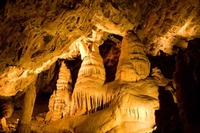
Minnetonka Cave
Bear Lake County, Idaho
Minnetonka Cave, located in the Caribou-Targhee
National Forest at the north end of Bear Lake in southeaster Idaho, is the
largest limestone cave in Idaho. The
cave features stalactites and stalagmites.
Numerous fossils of animals that lived in the tropical waters of the
Mississippian Period are found in the cave walls and ceiling. These fossils include: horned coral, honeycombed coral, brachiopods,
bryozoans, and crinoid stems.
Rockhounding Sites for Children & Families
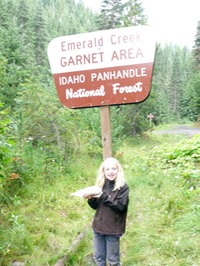
I visited the Emerald Creek Garnet Area in Spring 2009.
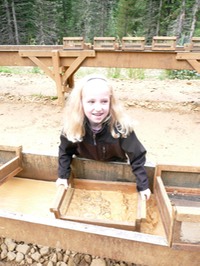
Finding garnets requires some work.
Star Garnets
Emerald Creek Garnet Area - Near Clarkia, Idaho
The Forest Service has developed the Emerald
Creek Garnet Area as a place where the public may collect star garnets. In the past, people would dig in the stream
bed in search of the garnets. Now, due
to concerns for water quality, aquatic habitat, and public safety, the Forest
Service provides a stockpile of garnet bearing gravels from which people can
gather material to run through one of two sluice boxes in search of
garnets. The site is open during the
summer.

Opals
Spencer Opal Mines – Spencer, Idaho
Commercial
(fee access) business. The opal mine
site, located in northwestern Idaho west of Yellowstone National Park, occurs
in a rhyolite and obsidian flow full of gas pockets. The opal solution or silica was a secondary
deposit carried by geyser activity. The
opal was hydrothermally deposited inside hollow geodes in successive layers.
